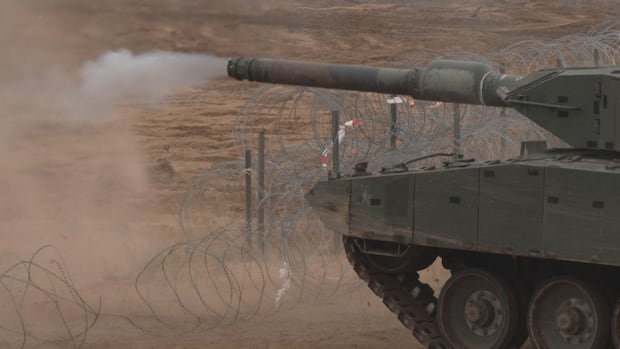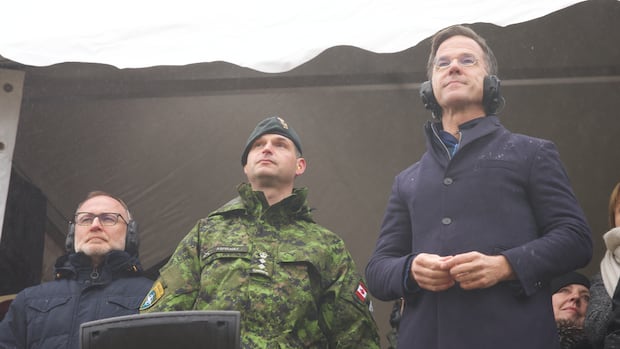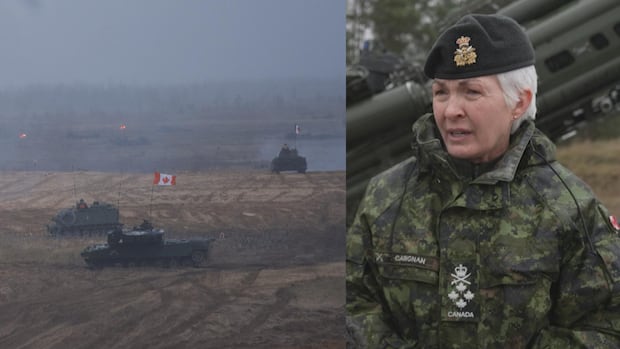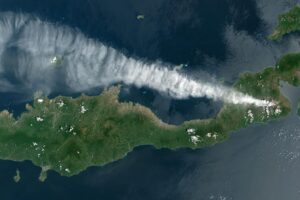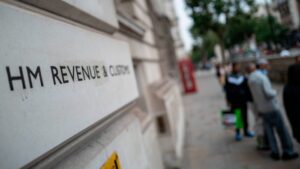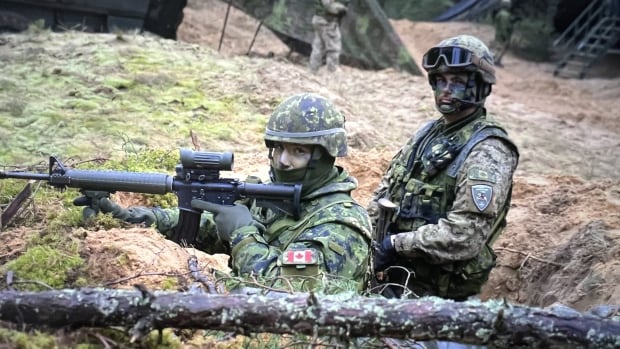
At the sprawling forested Ādaži military base, north east of Riga, Latvia, Capt. Harrison Burrows is one of more than 3,000 troops who has spent the past two weeks participating in a Canadian-led NATO military exercise designed to simulate an attack on the Baltic nation coming from beyond its nearly 300 km-long border with Russia.
It’s the first exercise held in Latvia since the military forces in the country were scaled up to a multinational brigade, also led by Canada, that is made up of troops and equipment from more than 13 nations.
“I would say 50 per cent if not more things that you see here today weren’t actually here earlier this summer,” Burrows said to CBC News during a press tour to the base on Wednesday, where combat vehicles, weaponry and a radar system were on display.
During the past six months of his deployment, Burrows, who is normally based at CFB Valcartier, witnessed how the various military units, and different pieces of equipment were integrated into a larger force as part of an effort to bolster NATO’s eastern flank.
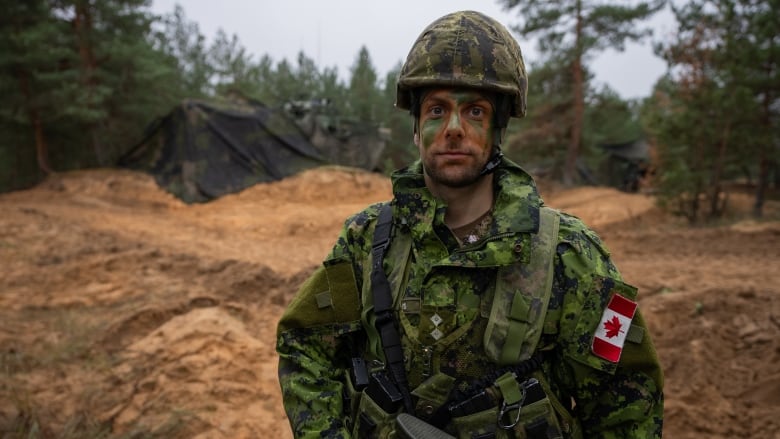
Asked about the U.S. presidential election, Burrows admitted that there was talk among troops around what would change after president-elect Donald Trump is sworn in in January.
“There’s been low-level discussions, but at the end of the day, our our mandate is for NATO,” said Burrows.
The Nov. 5 election of Donald Trump could potentially create friction in the 32 member alliance, given his past warnings that the U.S. will leave NATO nations to their own defences if they don’t spend more on defence.
Canadian forces and other NATO troops practise taking back territory from enemy forces in the Resolute Warrior military exercise near Riga, Latvia. The Canadian-led exercise involved 13 NATO countries and over 3,500 troops, of which 2,200 were Canadian.
Pressure expected from Trump
In February on the campaign trail Trump even said he would encourage Russia to do “whatever” it wants to allies that don’t pay up.
While at the time the White House called those comments “appalling and unhinged,” NATO’s Secretary General Mark Rutte, who previously served as the prime minister of the Netherlands and frequently met with Trump during his first term as president, describes Trump as someone who tries to invigorate the debate about defence spending.
“No doubt he will push [NATO countries] again to do more, to take a bigger share of the burden, which is only fair,” Rutte said in an interview with CBC News while attending the final day of the military exercises at Camp Ādaži.
“The U.S. is about 50 per cent of NATO’s economy, but they are doing more than 50 per cent of defence spending at the moment.”
NATO Secretary General Mark Rutte, who was in Latvia this week for NATO exercises, says in his first term as U.S. president Donald Trump ‘really invigorated’ the debate about defence spending — something Rutte expects to hear more about when Trump takes office again.
In 2023, the U.S. spent more than $900 billion US on defence, which accounts for more than 65 per cent of NATO’s overall military spending.
While NATO allies are expected to spend two per cent of their gross domestic product [GDP] on defence, a quarter of members don’t, including Canada, which is expected to spend under 1.4 per cent this year.
While Rutte says all NATO members need to spend “considerably more” than two per cent on defence, he pointed to Canada’s leadership of the multinational brigade as evidence of its commitment to supporting the security priorities of the alliance.
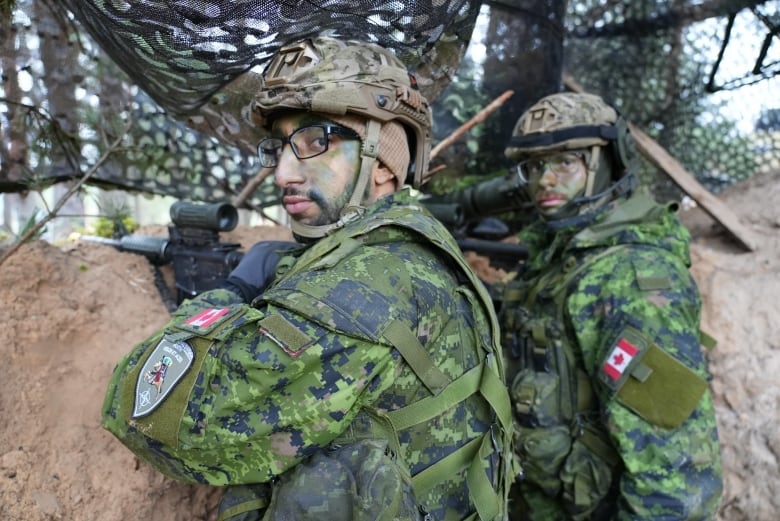
Canada deployed until 2026
Canada’s deployment to Latvia began in 2017 when hundreds of soldiers were stationed there as a part of a battlegroup.
In 2023, Canada committed $2. 6 billion to expand and continue the deployment until 2026.
Gen. Jennie Carignan, Canada’s chief of the defence staff told CBC News that she anticipates Canada’s largest international deployment to continue well beyond that.
“I think considering the actions of Russia and what’s going on in terms of threats, we can expect Canada to be here for a long time.”
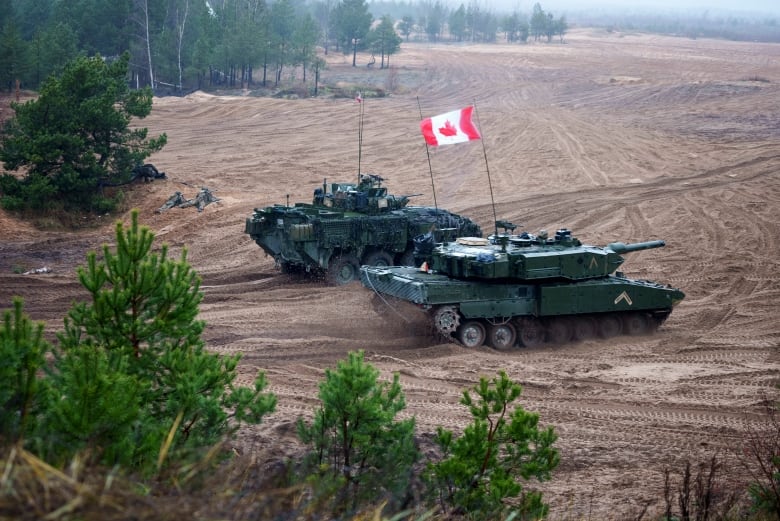
Most of the Canadian troops deployed to Latvia are on six-month rotations, and in January, for the first time, Sweden will be sending 600 troops as part of its first deployment as a new NATO member, having joined the alliance in March 2024.
Latvia, which was part of the Soviet Union until 1991 and has a large Russian population, fears that the Kremlin could try to take some of its territory .
Latvian President Edgars Rinkēvičs expressed gratitude for Canada’s commitment and hopes to see more investment, particularly in air defence.
Chief of the Defence Staff Gen. Jennie Carignan, speaking from Latvia where Canadian troops were participating in NATO exercises, says questions about incoming U.S. president Donald Trump are in the ‘high policy domain’ — but she stressed the relationship between the two militaries is stable and ‘not going to change.’
Canada says two additional air defence systems will be put in place in Latvia in 2026, and 2027.
“We all know what we need,” said Rinkēvičs who added that NATO countries could learn from Russia, which ramped up military production and is planning to spend over six per cent of its GDP on defence in 2025.
“We still are all living in a kind of land of hope. Unfortunately, we must face reality.”
